



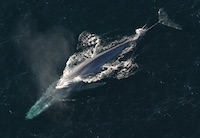

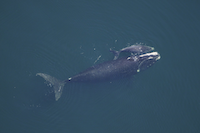

Bottlenose Dolphin
 |
Bottlenose dolphins are one of the most recognizable marine mammals in the world. They are known for their friendly and intelligent nature, and their playful behavior has captured the hearts of people around the globe. In this article, we will take a closer look at the bottlenose dolphin, exploring its physical characteristics, habitat, behavior, and conservation status.
Physical Characteristics
Bottlenose dolphins are easily recognizable by their distinctive curved mouths, which give the appearance of a permanent smile. They have a streamlined body shape and a dorsal fin on their back that can reach up to 18 inches in height. Their bodies are typically gray in color, although some individuals can have a slightly darker or lighter shade.
Adult bottlenose dolphins can grow up to 12 feet in length and weigh between 440-660 pounds. Females are generally smaller than males, and their bodies are more slender. Bottlenose dolphins have excellent eyesight and hearing, and they use echolocation to navigate their surroundings and locate prey.
Habitat
Bottlenose dolphins can be found in oceans and coastal waters all around the world. They are particularly common in warmer waters, such as the waters around Florida and the Caribbean, but can also be found in cooler waters, such as those off the coast of Scotland.
These dolphins are highly adaptable and can live in a variety of habitats, including shallow bays, estuaries, and deeper offshore waters. They are also known to venture up rivers and into freshwater environments.
Behavior
Bottlenose dolphins are social animals that typically live in groups, known as pods. These pods can range in size from a few individuals to several hundred. Within the pod, there is a complex social hierarchy, with individuals displaying dominance over others.
These dolphins are also known for their playful behavior. They have been observed riding waves, leaping out of the water, and playing with objects such as seaweed and pieces of coral. They are highly intelligent animals and have been observed using tools to catch prey, such as using sponges to protect their snouts when foraging in rocky areas.
Conservation Status
Bottlenose dolphins are not currently considered endangered, but they are still vulnerable to threats such as habitat loss, pollution, and entanglement in fishing gear. In some areas, dolphins are hunted for their meat or captured for use in marine parks and aquariums.
Conservation efforts are in place to protect bottlenose dolphins and their habitats. In some areas, restrictions have been put in place to limit the use of fishing gear that could entangle dolphins, and efforts are being made to reduce pollution in the oceans. Marine parks and aquariums are also increasingly focused on providing a safe and healthy environment for the dolphins in their care.
Orca
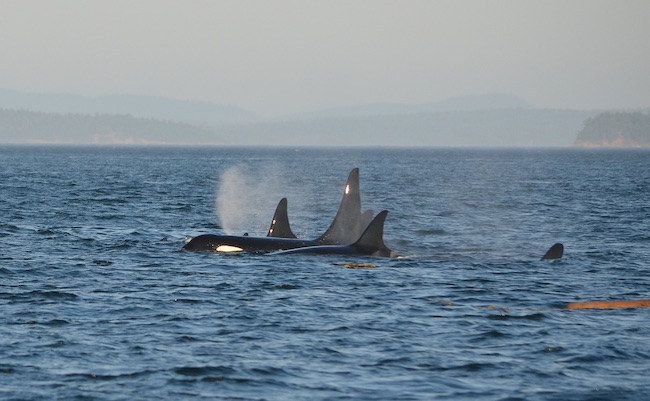 |
The orca, also known as the killer whale, is one of the most iconic marine mammals in the world. These highly intelligent and social animals have captured the imagination of people for generations, with their distinctive black and white markings and their reputation as apex predators. In this article, we will explore the physical characteristics, habitat, behavior, and conservation status of the orca.
Physical Characteristics
Orcas are the largest members of the dolphin family and can grow up to 32 feet in length and weigh over 6 tons. They have a sleek, streamlined body shape, with a tall dorsal fin on their back that can reach up to 6 feet in height. Orcas are typically black on their upper bodies and white on their undersides, with a distinctive white patch above their eyes.
Their teeth are another characteristic feature of orcas. They have up to 50 conical teeth in their jaws, which can grow up to 4 inches in length. These teeth are used to catch and kill prey, such as fish, squid, and other marine mammals.
Habitat
Orcas can be found in all of the world's oceans, from the Arctic to the Antarctic. They are highly adaptable animals and can live in a variety of environments, from shallow coastal waters to deep offshore areas.
Orcas are also known to travel long distances in search of food. Some populations are known to migrate over 10,000 miles each year, following the movements of their prey.
Behavior
Orcas are highly social animals and typically live in groups, known as pods. These pods can range in size from a few individuals to over 50, and are usually composed of females and their offspring.
Orcas are also known for their intelligence and complex social behavior. They use a variety of vocalizations to communicate with each other, and are thought to have a highly developed system of social bonds and hierarchy.
Orcas are also apex predators, meaning they are at the top of the food chain in their environment. They have been known to hunt a variety of prey, including fish, squid, seals, and even other marine mammals such as whales and dolphins. Different groups of orcas are known to specialize in hunting specific prey using unique methods. Pods of orcas are even known to gang up and prey on great white sharks.
Conservation Status
Orcas are currently considered a species of least concern by the International Union for Conservation of Nature (IUCN), but some populations are at risk due to a variety of threats.
One of the main threats to orcas is habitat loss and degradation, due to factors such as pollution, oil spills, and noise pollution from shipping and other human activities. Climate change is also a major concern, as rising temperatures and ocean acidification can impact the availability of prey and disrupt migration patterns.
Orcas are also vulnerable to hunting, both for their meat and for use in entertainment facilities such as marine parks and aquariums. Captive orcas are often kept in small tanks and are subjected to stress and psychological trauma, which can impact their health and wellbeing.
Narwhal
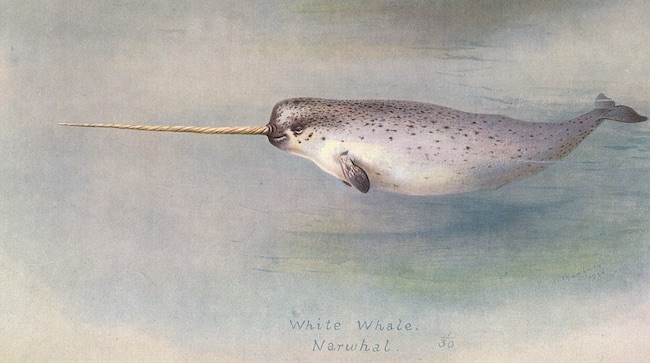 |
The narwhal is a unique and fascinating marine mammal that is native to the Arctic waters of Canada, Greenland, Norway, and Russia. With its long, spiraled tusk and distinctive mottled skin, the narwhal has captured the imagination of people around the world. In this article, we will explore the physical characteristics, habitat, behavior, and conservation status of the narwhal.
Physical Characteristics
The narwhal is a medium-sized whale that can grow up to 20 feet in length and weigh up to 3,500 pounds. It has a mottled gray or brown skin that helps it blend into the icy waters of the Arctic, and its body is shaped like a torpedo for efficient swimming.
The most distinctive feature of the narwhal is its long, spiraled tusk. This tusk is actually a long, protruding tooth that can grow up to 10 feet in length. The tusk is only found in males, and its exact function is still a subject of scientific debate. Some theories suggest that the tusk may be used for display or as a weapon during mating or territorial battles, while others suggest that it may be used for sensory purposes, such as detecting changes in water temperature or salinity.
Habitat
The narwhal is found in the Arctic waters of Canada, Greenland, Norway, and Russia. It is a highly specialized species that is adapted to life in the extreme conditions of the Arctic. The narwhal spends much of its time diving to depths of up to 1,500 meters to feed on a variety of fish, squid, and shrimp.
Behavior
Narwhals are highly social animals that live in groups known as pods. These pods can range in size from a few individuals to over 1,000, and are typically composed of females and their offspring. Male narwhals typically live alone or in small groups.
Narwhals are known for their unique vocalizations, which they use to communicate with each other. They also use body language, such as tail slapping and breaching, to convey information.
Conservation Status
The narwhal is currently listed as "near threatened" by the International Union for Conservation of Nature (IUCN), due to a variety of threats to its habitat and population.
One of the main threats to the narwhal is climate change, which is causing rapid melting of Arctic sea ice and changes in ocean currents. This is affecting the availability of food for narwhals and is also impacting their breeding patterns.
Narwhals are also vulnerable to hunting, both by indigenous peoples for subsistence and by commercial whalers. The trade in narwhal ivory is also a concern, as the tusk is highly valued in some cultures for its use in traditional carving and art.
Amazon River Dolphin
 |
frank wouters, CC BY 2.0, via Wikimedia Commons
The Amazon River Dolphin, also known as the pink river dolphin or boto, is a fascinating aquatic mammal that inhabits the freshwater rivers and tributaries of the Amazon basin. With its unique pink coloration and distinctive features, the Amazon River Dolphin is an important part of the Amazonian ecosystem and a beloved cultural icon for many indigenous communities. In this article, we will explore the physical characteristics, habitat, behavior, and conservation status of the Amazon River Dolphin.
Physical Characteristics
The Amazon River Dolphin is a relatively small species of dolphin, growing to a maximum length of around 8 feet and weighing up to 400 pounds. Its most striking feature is its pink coloration, which is caused by a high concentration of blood vessels near the surface of its skin. This pink coloration is most pronounced in adult males, and tends to fade in females and juveniles.
In addition to its pink coloration, the Amazon River Dolphin has a number of other distinctive features. It has a long, narrow beak that is adapted for hunting fish in shallow water, and its eyes are small and beady, indicating that it relies more on echolocation than vision to navigate its environment. It also has a flexible neck that allows it to move its head in a variety of directions, making it easier to maneuver through the densely vegetated rivers and tributaries of the Amazon basin.
Habitat
The Amazon River Dolphin is found exclusively in the freshwater rivers and tributaries of the Amazon basin, which includes parts of Brazil, Peru, Colombia, Bolivia, and Ecuador. It is adapted to life in these murky, shallow waters, and is able to navigate through dense vegetation and shallow sandbars to hunt for fish and other prey.
Behavior
Amazon River Dolphins are highly social animals that live in groups known as pods. These pods can range in size from a few individuals to over 100, and are typically composed of females and their offspring. Males tend to be more solitary, although they may form small groups during mating season.
The Amazon River Dolphin is a highly intelligent and adaptable species, with a number of unique behaviors that distinguish it from other species of dolphins. For example, it is known to engage in cooperative hunting with other dolphins, and is also capable of swimming upside-down to navigate through dense vegetation. It also has a unique vocal repertoire, which includes a variety of clicks, whistles, and other sounds that it uses to communicate with other dolphins.
Conservation Status
The Amazon River Dolphin is currently listed as "data deficient" by the International Union for Conservation of Nature (IUCN), meaning that there is not enough data available to determine its conservation status with certainty. However, the species is believed to be under threat from a variety of factors, including habitat loss and degradation, hunting, and accidental entanglement in fishing nets.
One of the main threats to the Amazon River Dolphin is the construction of dams and other hydroelectric projects in the Amazon basin, which can disrupt the flow of rivers and alter the availability of prey for dolphins. It is also vulnerable to hunting, both for its meat and for its oil, which is believed to have medicinal properties in some cultures.
Blue Whale
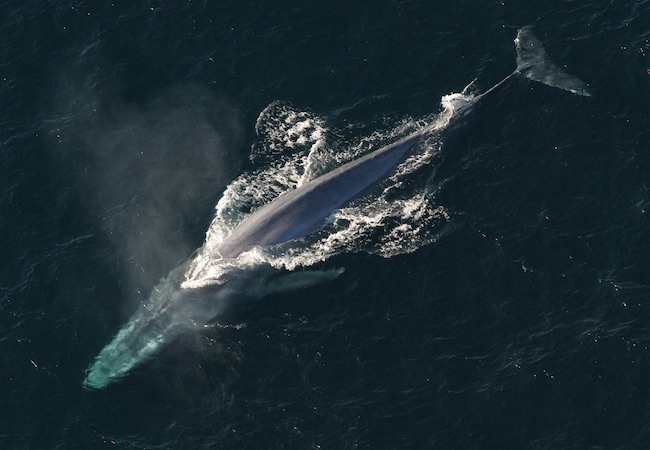 |
The blue whale, also known as the largest animal to have ever lived, is a remarkable marine mammal that captures the imagination of people around the world. This gentle giant is a true marvel of evolution, adapted perfectly to life in the world's oceans. In this article, we will explore the physical characteristics, habitat, behavior, and conservation status of the blue whale.
Physical Characteristics
The blue whale is the largest animal on the planet, with adults reaching lengths of up to 100 feet and weights of over 200 tons. Its enormous size is complemented by a sleek and streamlined body shape, allowing it to move through the water with incredible speed and agility.
Despite its massive size, the blue whale feeds almost exclusively on tiny shrimp-like animals called krill. To facilitate this specialized diet, the blue whale has a unique filtering system in its mouth that allows it to strain out krill from the water, while expelling the excess water through its baleen plates.
Habitat
Blue whales are found in all of the world's oceans, from the Arctic to the Antarctic. They tend to inhabit the open ocean, preferring deep waters where krill populations are highest. During the summer months, blue whales migrate to higher latitudes in search of abundant food sources, while during the winter months they migrate towards warmer waters to breed and give birth.
Behavior
Despite their enormous size, blue whales are relatively solitary animals that tend to travel alone or in small groups. They are known for their incredible vocalizations, which can be heard over great distances in the water. These vocalizations are thought to be used for communication, navigation, and mating purposes.
Blue whales are also known for their incredible diving abilities, with some individuals able to dive to depths of over 1,000 feet and stay submerged for up to 30 minutes at a time. During these dives, the blue whale's heart rate slows down dramatically to conserve oxygen and allow it to stay underwater for longer periods of time.
Conservation Status
The blue whale was heavily hunted during the 20th century for its valuable blubber and oil, resulting in a dramatic decline in its population. Today, the species is listed as endangered by the International Union for Conservation of Nature (IUCN), and it is estimated that there are only around 10,000-25,000 individuals left in the wild.
Conservation efforts are focused on reducing human impacts on the species, such as reducing shipping traffic and noise pollution, and limiting the use of commercial fishing gear that can accidentally entangle and kill blue whales. Research is also being conducted to better understand the species' migration patterns and population dynamics, which can help inform conservation efforts in the future.
Humpback Whale
 |
The humpback whale, with its iconic knobbly head and long pectoral fins, is a beloved species of marine mammal that captures the hearts of people around the world. These majestic creatures are known for their impressive acrobatic displays and haunting songs, making them a popular attraction for whale watchers and nature enthusiasts. In this article, we will explore the physical characteristics, habitat, behavior, and conservation status of the humpback whale.
Physical Characteristics
Humpback whales are large animals, with adults reaching lengths of up to 50 feet and weights of up to 40 tons. They are characterized by their knobbly head, long pectoral fins, and distinctive black and white coloration on their underside. Humpback whales are also known for their acrobatic displays, which include breaching, tail slapping, and flipper waving.
Habitat
Humpback whales are found in all of the world's oceans, from the polar regions to the tropics. During the summer months, they migrate towards higher latitudes in search of food, while during the winter months they migrate towards warmer waters to breed and give birth. Humpback whales are known to feed on small fish and krill, and they often employ unique hunting techniques such as bubble net feeding, where they blow bubbles to corral their prey before lunging towards them with their mouth open.
Behavior
Humpback whales are known for their intricate songs, which are sung by males during the breeding season. These songs can last for up to 20 minutes and are thought to play a role in attracting mates and establishing territory. Humpback whales are also social animals that often travel in small groups, known as pods. These pods can consist of family members or unrelated individuals that come together for socialization and protection.
Conservation Status
Like many species of whales, humpback whales were heavily hunted for their valuable blubber and oil during the 20th century. However, due to international conservation efforts, the humpback whale population has since recovered and is now listed as a species of "Least Concern" by the International Union for Conservation of Nature (IUCN).
Despite this positive trend, humpback whales still face a number of threats in the wild, including entanglement in fishing gear, ship strikes, and pollution. To protect humpback whales, conservation efforts are focused on reducing these threats through measures such as reducing fishing gear entanglement, implementing ship speed restrictions, and reducing ocean pollution.
North Atlantic Right Whale
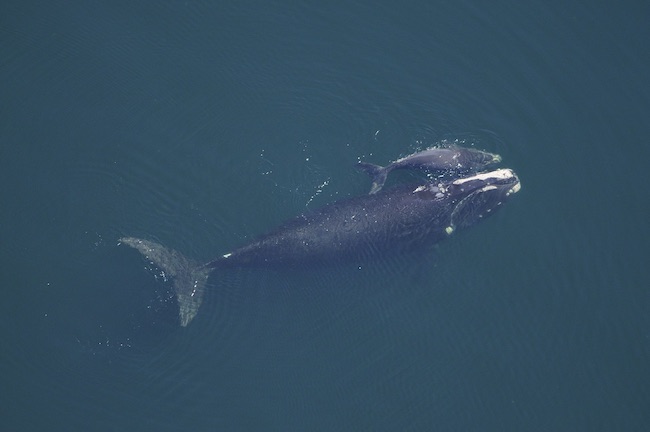 |
Cede Prudente, World Wildlife Fund, Malaysia., CC BY 2.5, via Wikimedia Commons
The North Atlantic right whale is a large marine mammal that inhabits the waters of the North Atlantic Ocean. They are one of the most endangered species of whales, with only around 350 individuals remaining in the wild. In this article, we will explore the physical characteristics, habitat, behavior, and conservation status of the North Atlantic right whale.
Physical Characteristics
The North Atlantic right whale is a large animal, with adults reaching lengths of up to 50 feet and weights of up to 70 tons. They are characterized by their large, triangular head, which can be up to one-third of their total body length. They are also known for their distinctive V-shaped blow and lack of a dorsal fin. North Atlantic right whales have a thick layer of blubber, which helps to keep them warm in the cold waters of the North Atlantic.
Habitat
North Atlantic right whales are found in the waters of the North Atlantic Ocean, primarily in the coastal waters of the United States and Canada. They migrate to warmer waters in the winter to breed and give birth, and then move to colder waters in the summer to feed. North Atlantic right whales are known to feed on plankton and small crustaceans, using baleen plates to filter their food from the water.
Behavior
North Atlantic right whales are known for their slow swimming speed and their habit of floating at the surface of the water. They are also known for their vocalizations, which include a variety of sounds such as moans, groans, and high-pitched squeaks. North Atlantic right whales are also social animals, often found in groups of up to 12 individuals.
Conservation Status
The North Atlantic right whale is one of the most endangered species of whales, with only around 350 individuals remaining in the wild. The species was heavily hunted in the past for their valuable blubber and oil, and they continue to face a number of threats today. These threats include entanglement in fishing gear, ship strikes, and ocean noise pollution.
To protect North Atlantic right whales, a number of conservation efforts are underway. These include reducing fishing gear entanglement through the use of ropeless fishing gear, implementing ship speed restrictions in areas where North Atlantic right whales are known to congregate, and reducing ocean noise pollution through regulations on shipping and seismic exploration.
Beluga Whale
 |
The beluga whale, also known as the white whale, is a fascinating marine mammal that inhabits the Arctic and sub-Arctic regions of the world. In this article, we will explore the physical characteristics, habitat, behavior, and conservation status of the beluga whale.
Physical Characteristics
Beluga whales are easily recognizable by their distinctive white skin and rounded forehead, known as a melon. They are small to medium-sized whales, typically reaching lengths of 10 to 16 feet and weights of 1,100 to 3,500 pounds. Belugas have a thick layer of blubber, which helps to keep them warm in the cold waters of the Arctic. They are also known for their vocalizations, which include a variety of whistles, clicks, and chirps.
Habitat
Beluga whales are found in the Arctic and sub-Arctic regions of the world, including the waters around Alaska, Canada, Greenland, and Russia. They are highly adapted to life in the cold waters of the Arctic, and their white skin provides excellent camouflage in the icy environment. Beluga whales are also known to migrate up rivers and into estuaries to feed during the summer months.
Behavior
Beluga whales are social animals, often found in groups of up to 10 individuals, although larger groups of several hundred have been observed. They are also known for their acrobatic behavior, such as breaching, spy-hopping, and tail-slapping. Beluga whales are opportunistic feeders, eating a variety of prey including fish, squid, and crustaceans.
Conservation Status
While the global population of beluga whales is not currently endangered, some local populations are facing significant threats. In particular, the beluga population in the Cook Inlet region of Alaska is listed as endangered due to habitat degradation, hunting, and pollution. Beluga whales are also vulnerable to climate change, which is impacting their Arctic habitat through melting sea ice and changes in ocean currents.
To protect beluga whales, conservation efforts are underway to address these threats. These include efforts to reduce pollution and habitat degradation in their habitat, and restrictions on hunting and commercial activities that could harm the species. In addition, efforts are being made to better understand the biology and behavior of beluga whales to help inform conservation strategies.
Conclusion
The beluga whale is a remarkable species that is highly adapted to life in the Arctic environment. While some populations are facing significant threats, conservation efforts are underway to protect this species for future generations. As we continue to learn more about the biology and behavior of beluga whales, it is important that we work towards protecting their habitat and reducing our impact on the world's oceans for the benefit of both the beluga whale and all marine life.